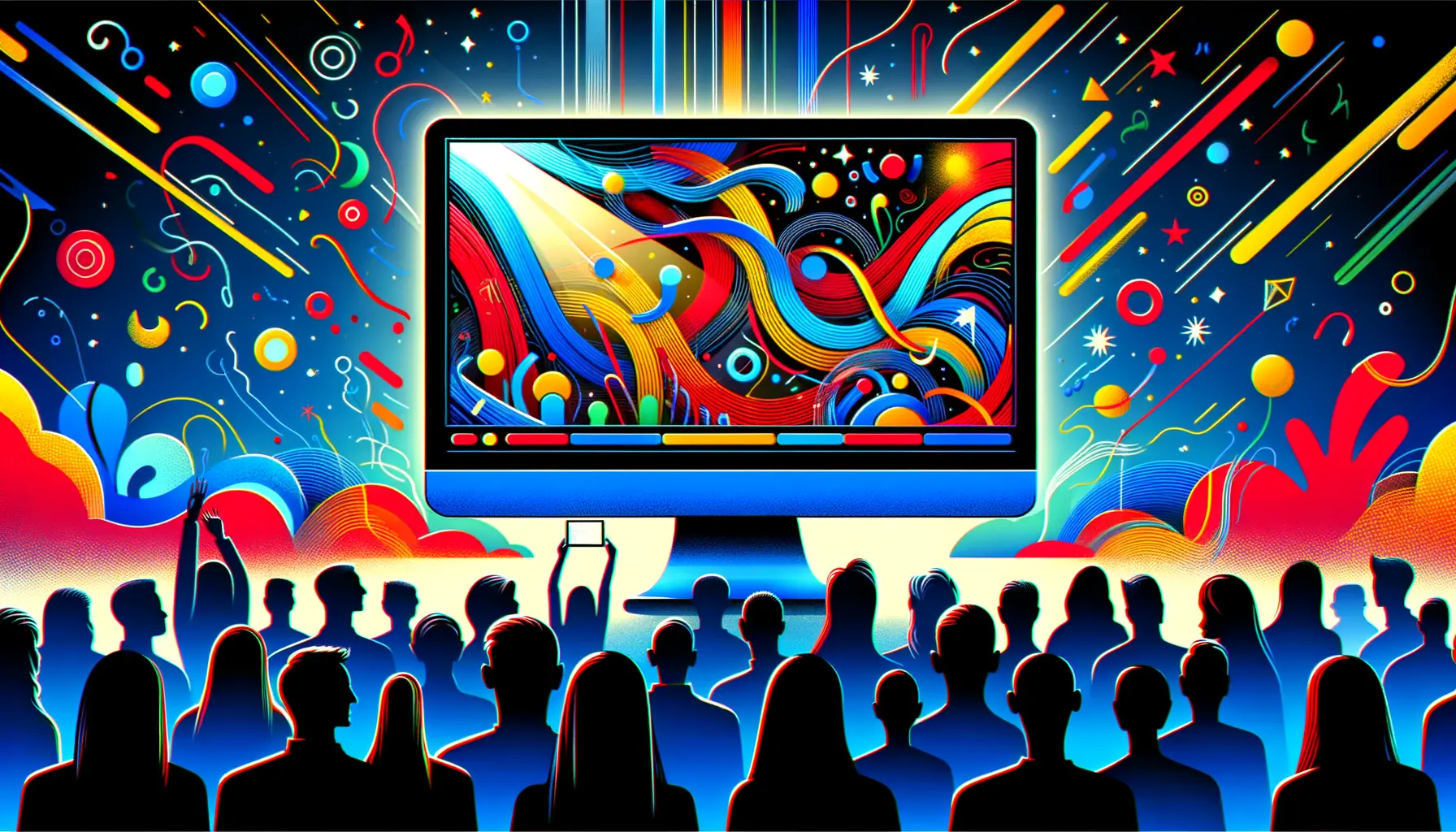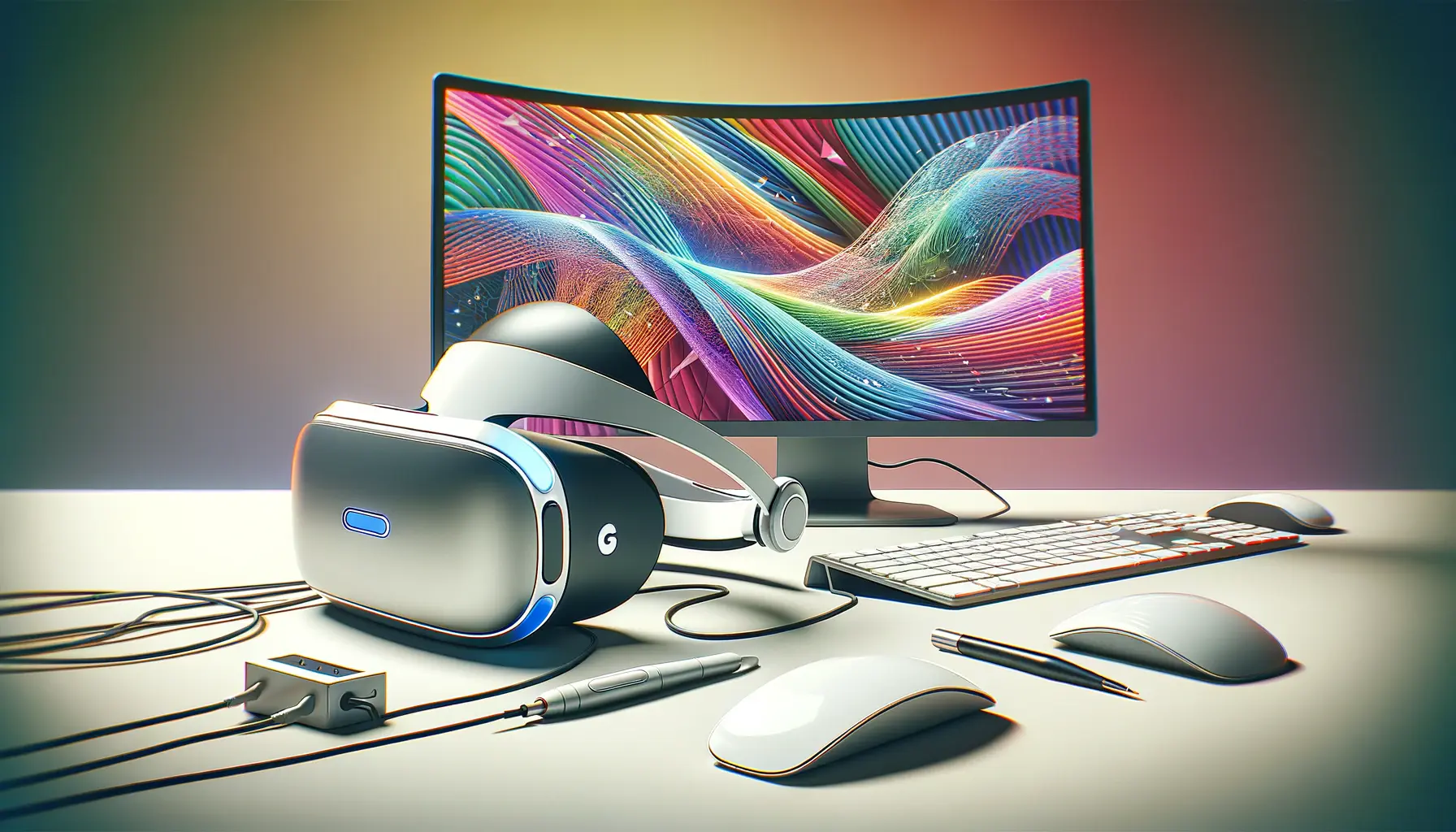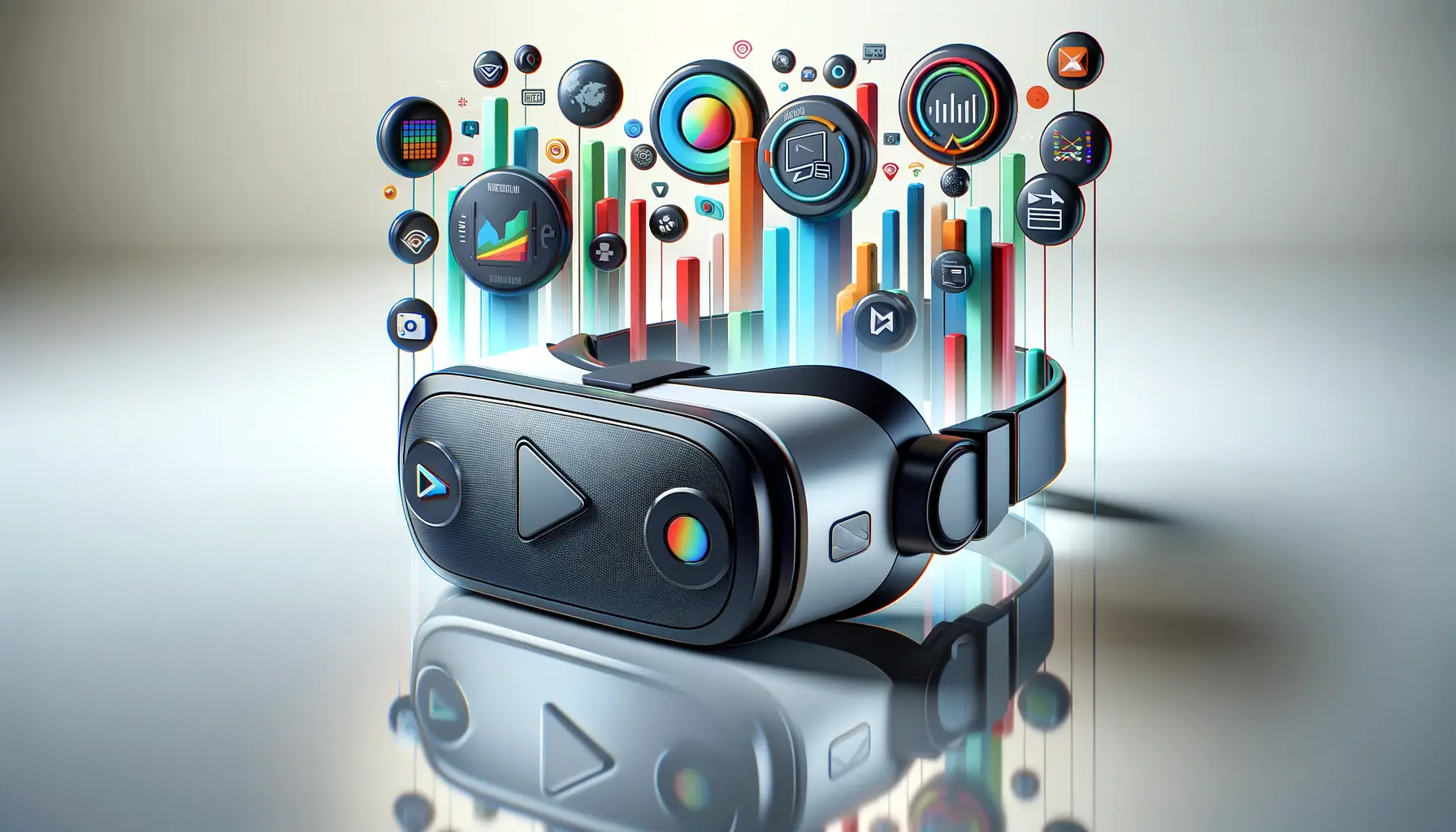The digital landscape is evolving at an unprecedented pace, with virtual reality (VR) at the forefront of this technological revolution.
As we stand on the brink of a new era, the integration of VR into our daily lives promises to transform how we interact with the digital world.
Yet, as we navigate through these exciting advancements, the imperative of web accessibility cannot be overstated.
Ensuring that VR technologies are accessible to all, including individuals with disabilities, is not just a matter of legal compliance or ethical responsibility; it’s a cornerstone for fostering an inclusive digital future.
Virtual reality, once a concept confined to the realms of science fiction, is now a tangible, immersive experience that offers a new dimension of interaction with digital content.
From education and healthcare to gaming and entertainment, the applications of VR are vast and varied.
However, as we embrace these possibilities, we encounter the challenge of making these technologies accessible.
The question of how VR can be designed and developed to accommodate the needs of all users, including those with visual, auditory, motor, and cognitive disabilities, is critical for the advancement of web accessibility.
- Understanding Virtual Reality and Its Potential
- Designing for Accessibility in Virtual Environments
- Technological Innovations Enhancing VR Accessibility
- Best Practices for VR Content Creation and Testing
- Legal and Ethical Considerations in VR Accessibility
- Global Trends and Future Directions in VR Accessibility
- Collaborative Efforts and Community Engagement in VR Accessibility
- Envisioning an Accessible Future in Virtual Reality
- FAQs on Virtual Reality and Web Accessibility
Understanding Virtual Reality and Its Potential
At its core, virtual reality is a technology that creates a simulated environment, offering users an immersive experience that can mimic the real world or conjure fantastical landscapes.
Unlike traditional user interfaces, VR places the individual inside an experience, where instead of viewing a screen in front of them, users are enveloped in a 3D world.
By simulating as many senses as possible, such as vision, hearing, touch, and even smell, VR can transport users to a different place, time, or setting.
The potential of VR extends beyond entertainment, opening new avenues for education, training, therapy, and remote work.
For instance, medical students can practice surgeries in a risk-free virtual environment, while architects can walk clients through virtual models of their designs.
The immersive nature of VR also holds significant promise for enhancing web accessibility.
By creating environments that can be tailored to individual needs, VR can offer unique solutions to overcome traditional barriers faced by people with disabilities.
Challenges to Web Accessibility in VR
Despite its potential, the integration of VR into web accessibility faces several challenges.
The immersive nature of VR, which relies heavily on visual and auditory inputs, presents unique obstacles for individuals with visual and hearing impairments.
Navigating a 3D environment can be daunting without the traditional cues available on a 2D web page.
Moreover, the physical interaction required by VR devices, such as headsets and controllers, may exclude users with motor disabilities who cannot use these devices in conventional ways.
Addressing these challenges requires innovative solutions and a commitment to inclusive design from the outset.
Developers and designers must consider a wide range of disabilities to ensure VR technologies are not only accessible but also provide a meaningful experience for all users.
This includes developing alternative input methods, such as voice control and gesture recognition, and ensuring that VR content is compatible with assistive technologies.
The future of virtual reality and web accessibility hinges on our ability to innovate and embrace inclusive design principles. By doing so, we can unlock the full potential of VR as a tool for enhancing the digital experiences of all users, regardless of their abilities.
Designing for Accessibility in Virtual Environments
Creating virtual environments that are accessible to everyone, including people with disabilities, is a multifaceted challenge that requires a deep understanding of diverse needs.
Designing for accessibility in VR involves more than just adapting existing web standards; it necessitates a reimagining of how users interact with digital content in three-dimensional spaces.
To ensure VR technologies are inclusive, developers and designers must consider a variety of factors, from the initial design phase through to development and testing.
Here are key considerations and strategies for enhancing accessibility in virtual environments:
Key Considerations for Accessible VR Design
- User-Centered Design: Involve users with disabilities in the design process to gather insights and feedback on usability and accessibility.
- Multi-Sensory Experiences: Incorporate auditory, haptic (touch), and visual feedback to cater to users with different sensory impairments.
- Customizable Interfaces: Allow users to adjust settings such as text size, color contrast, and audio levels to suit their individual needs.
- Navigation and Orientation: Design intuitive navigation systems that do not solely rely on visual cues, incorporating audio directions and tactile feedback for guidance.
Strategies for Enhancing VR Accessibility
- Implementing Voice Commands and Speech Recognition: Enable users to interact with the VR environment through voice commands, reducing the reliance on physical controllers.
- Developing Adaptive Controllers: Create controllers that can be customized for different levels of motor ability, including those that can be operated with one hand or through head movements.
- Utilizing Audio Descriptions for Visual Content: Provide descriptive audio tracks for users who are blind or have low vision, ensuring they can fully engage with the VR experience.
- Offering Sign Language Interpretation: Include sign language avatars or video overlays for users who are deaf or hard of hearing, ensuring all audio content is accessible.
By integrating these considerations and strategies into the development of VR technologies, we can create virtual environments that are not only accessible but also enriching for all users.
This approach not only meets the ethical and legal obligations of web accessibility but also expands the potential user base for VR applications, making them more universally appealing and usable.
Inclusive design in virtual reality is not just about removing barriers; it’s about creating a seamless and engaging experience for every user, showcasing the true potential of VR as a platform for innovation and accessibility.
Technological Innovations Enhancing VR Accessibility
The rapid advancement of technology plays a pivotal role in enhancing the accessibility of virtual reality.
Innovations in hardware and software are making VR experiences more inclusive, breaking down the barriers that have traditionally excluded people with disabilities.
These technological breakthroughs are not just expanding the boundaries of what’s possible within virtual environments; they’re also setting new standards for accessibility in the digital age.
Let’s explore some of the cutting-edge technologies and developments that are paving the way for more accessible VR experiences:
Advancements in Haptic Feedback Technology
Haptic feedback technology, which simulates the sense of touch through vibrations and motions, is revolutionizing the way users interact with VR.
For individuals with visual impairments, haptic feedback provides tangible cues about their virtual surroundings, enabling them to navigate and interact with environments in ways previously unimaginable.
Innovations in haptic wearables, such as gloves and vests, offer nuanced sensations that mimic real-world interactions, from the texture of objects to the impact of movements, enhancing the immersive experience for all users.
Adaptive and Customizable Controllers
The development of adaptive and customizable controllers is another significant leap forward in VR accessibility.
These controllers are designed to accommodate a wide range of physical abilities, featuring adjustable layouts, sensitivity settings, and modes of operation.
Some innovative controllers can be operated with minimal movement or even through eye tracking and facial expressions, ensuring users with motor impairments can fully engage with VR content without the need for traditional hand-held devices.
Artificial Intelligence and Machine Learning
Artificial intelligence (AI) and machine learning are at the forefront of creating more accessible VR experiences.
AI-driven systems can adapt in real-time to the needs of users, offering personalized adjustments to the VR environment.
For example, AI can automatically modify the contrast and size of text for users with low vision or generate real-time audio descriptions of visual content.
Machine learning algorithms can also learn from user interactions, continuously improving the accessibility of VR applications based on feedback and usage patterns.
Speech Recognition and Natural Language Processing
Speech recognition and natural language processing technologies enable users to control VR environments using voice commands, making VR more accessible to individuals with motor impairments.
These technologies allow for hands-free navigation and interaction, providing an alternative to physical controllers.
Additionally, natural language processing can facilitate real-time communication within VR, offering speech-to-text and text-to-speech capabilities for users who are deaf or hard of hearing, ensuring they can participate in social and collaborative VR experiences.
Technological innovations are key to unlocking the full potential of virtual reality for all users, regardless of their physical or cognitive abilities. By embracing these advancements, we can create VR experiences that are not only accessible but also deeply enriching and engaging.
Best Practices for VR Content Creation and Testing
As virtual reality becomes more integrated into our digital lives, the importance of creating and testing VR content with accessibility in mind cannot be overstated.
Ensuring that VR experiences are accessible to all users, including those with disabilities, requires a thoughtful approach to content creation and a rigorous testing process.
By adhering to best practices in these areas, developers can significantly enhance the usability and inclusiveness of VR technologies.
Here are essential best practices for VR content creation and testing to ensure accessibility:
Inclusive Content Creation Strategies
- Design with Diversity in Mind: Consider the wide range of users from the outset. Incorporate diverse perspectives and needs into the design process to ensure VR content is universally accessible.
- Use Clear and Simple Language: Opt for straightforward language that is easy to understand, making the content accessible to users with cognitive disabilities and those for whom the language may not be their first.
- Provide Multiple Ways to Interact: Offer various interaction methods, such as voice commands, gesture control, and traditional controllers, to accommodate different abilities and preferences.
- Ensure Compatibility with Assistive Technologies: Make VR content compatible with screen readers, magnifiers, and other assistive technologies to enhance accessibility for users with visual impairments.
Rigorous Testing for Accessibility
- Involve Users with Disabilities in Testing: Engage individuals with a range of disabilities in the testing process to gather valuable insights and feedback on the accessibility of VR content.
- Use Standardized Accessibility Checklists: Employ checklists based on established web accessibility guidelines, such as the Web Content Accessibility Guidelines (WCAG), to evaluate VR content systematically.
- Conduct Iterative Testing: Implement a cycle of testing, feedback, and revision to continuously improve the accessibility of VR experiences throughout the development process.
- Test Across Different Devices and Platforms: Ensure VR content is accessible on various devices and platforms, considering the unique challenges and capabilities of each.
By following these best practices for VR content creation and testing, developers can create more inclusive and accessible virtual reality experiences.
This not only broadens the appeal and usability of VR technologies but also ensures that they serve as a tool for empowerment and inclusion, rather than exclusion.
Accessibility should be a priority, not an afterthought, in the creation and testing of VR content. Adopting these best practices is a step toward building a more inclusive digital world where everyone can benefit from the immersive possibilities of virtual reality.
Legal and Ethical Considerations in VR Accessibility
The rapid evolution of virtual reality technologies brings to the forefront not only technical challenges but also significant legal and ethical considerations.
As VR becomes more pervasive across various sectors, ensuring accessibility for all users is not just a matter of innovation and inclusivity but also of legal compliance and ethical responsibility.
The landscape of digital accessibility laws and ethical guidelines is evolving, reflecting the need to address the unique challenges posed by immersive technologies like VR.
Understanding these legal and ethical considerations is crucial for developers, content creators, and policymakers involved in the VR ecosystem:
Legal Frameworks Governing VR Accessibility
- Web Content Accessibility Guidelines (WCAG): While primarily designed for web content, WCAG principles are increasingly being applied to VR to ensure that digital experiences are accessible to people with disabilities.
- Americans with Disabilities Act (ADA): In the United States, the ADA mandates that digital and information technology, including VR, must be accessible to individuals with disabilities, setting a precedent for legal requirements worldwide.
- European Accessibility Act (EAA): In Europe, the EAA aims to improve the accessibility of products and services, including digital content and technologies like VR, for people with disabilities.
Ethical Guidelines for VR Development
- Ensure Equitable Access: Developers should strive to create VR experiences that are accessible to users with a wide range of abilities, ensuring equitable access to the benefits of VR technology.
- Promote Inclusion and Diversity: VR content should reflect and respect the diversity of users, including those with disabilities, promoting an inclusive and respectful virtual environment.
- Protect User Privacy and Data: Ethical VR development must include stringent measures to protect users’ privacy and personal data, especially when collecting sensitive information related to accessibility needs.
Adhering to these legal and ethical considerations is essential for fostering a VR ecosystem that is not only innovative and immersive but also inclusive and respectful of all users’ rights and dignity.
By navigating these considerations thoughtfully, the VR community can ensure that virtual reality serves as a force for good, enhancing the lives of users across the spectrum of abilities.
The intersection of legal compliance, ethical responsibility, and technological innovation in VR accessibility underscores the importance of a multidisciplinary approach to creating virtual experiences that are truly accessible to everyone.
Global Trends and Future Directions in VR Accessibility
The landscape of virtual reality is constantly evolving, with new trends emerging that shape the future of VR accessibility.
As technology advances, so does the potential to create more inclusive and accessible virtual environments.
These global trends not only reflect the current state of VR development but also indicate where the industry is headed, highlighting the ongoing commitment to making VR experiences available to everyone, regardless of their physical or cognitive abilities.
Let’s explore some of the most significant global trends and future directions in VR accessibility:
Increasing Adoption of VR in Education and Training
One of the most promising trends is the growing use of VR for educational and training purposes.
Virtual reality offers unique opportunities for immersive learning experiences that can be tailored to the needs of learners with disabilities.
For example, VR simulations can provide hands-on learning experiences for students who may not be able to participate in traditional classroom settings.
This trend is likely to continue, with VR becoming an integral tool in personalized education and professional training programs.
Advancements in Immersive Therapy and Rehabilitation
VR technology is increasingly being recognized for its potential in therapeutic and rehabilitation settings.
Virtual environments can be designed to support physical, cognitive, and psychological rehabilitation programs, offering safe and controlled spaces for therapy.
For individuals with disabilities, VR-based therapies can facilitate motor skill development, cognitive rehabilitation, and social interaction, contributing to improved health outcomes and quality of life.
Collaboration and Standardization Efforts
As the VR industry matures, there is a growing emphasis on collaboration and standardization to ensure accessibility.
Industry leaders, developers, and accessibility advocates are coming together to establish guidelines and standards for VR accessibility.
These collaborative efforts aim to create a unified framework for designing and testing VR content, ensuring that accessibility considerations are integrated into the development process from the outset.
Emergence of New Technologies and Interfaces
The future of VR accessibility is also tied to the emergence of new technologies and interfaces that enhance user interaction.
Innovations in brain-computer interfaces (BCIs), augmented reality (AR), and mixed reality (MR) are expanding the ways in which users can engage with virtual environments.
These technologies offer exciting possibilities for creating more intuitive and accessible VR experiences, potentially transforming how people with disabilities interact with digital content.
The ongoing evolution of VR technology, driven by global trends and innovations, holds great promise for enhancing accessibility. By embracing these developments, the VR community can ensure that virtual reality becomes a tool for inclusion, empowering users of all abilities to explore, learn, and connect in new and meaningful ways.
Collaborative Efforts and Community Engagement in VR Accessibility
The journey towards fully accessible virtual reality experiences is not a solitary endeavor.
It requires the collective efforts of developers, users, advocates, and organizations dedicated to the cause of digital accessibility.
Collaborative efforts and community engagement play a crucial role in identifying challenges, developing solutions, and advocating for the inclusion of all users in the virtual world.
By working together, the VR community can accelerate progress towards a more inclusive digital future.
Here are key areas where collaborative efforts and community engagement are making an impact:
Partnerships Between Developers and Accessibility Organizations
- Joint Development Projects: Collaborations between VR developers and accessibility organizations lead to the creation of VR content and technologies that are inherently accessible.
- Accessibility Consulting: Accessibility experts provide invaluable insights and guidance to VR development teams, ensuring that accessibility is integrated into the design and development process.
User-Centered Design and Feedback Loops
- Involving Users with Disabilities: Engaging directly with users who have disabilities in the design, testing, and feedback processes ensures that VR experiences meet their needs and preferences.
- Community Testing Programs: Establishing community testing programs allows for a broader range of feedback and helps identify accessibility issues that may not be apparent to developers.
Advocacy and Awareness Campaigns
- Raising Awareness: Advocacy groups and community organizations play a vital role in raising awareness about the importance of VR accessibility, influencing public opinion and policy.
- Lobbying for Change: By lobbying for legislative and regulatory changes, advocates can ensure that accessibility standards are applied to VR technologies, promoting inclusivity at a systemic level.
Open Source Initiatives and Resource Sharing
- Development of Open Source Tools: The creation and sharing of open source accessibility tools and resources empower developers to build more accessible VR experiences.
- Community-Driven Knowledge Bases: Online forums, wikis, and repositories serve as valuable platforms for sharing knowledge, best practices, and solutions to common accessibility challenges.
Through these collaborative efforts and community engagement, the VR industry can harness a wealth of knowledge, experience, and creativity to overcome accessibility barriers.
By fostering an inclusive and participatory development culture, we can ensure that virtual reality becomes a space where everyone has the opportunity to explore, interact, and benefit from the immersive experiences it offers.
The path to accessible virtual reality is paved with collaboration, innovation, and community engagement. Together, we can build a VR ecosystem that is not only technologically advanced but also universally accessible and inclusive.
Envisioning an Accessible Future in Virtual Reality
The journey through the evolving landscape of virtual reality and web accessibility has illuminated the vast potential and the significant challenges that lie ahead.
As we stand at the intersection of technological innovation and inclusive design, it’s clear that the future of VR is not just about creating immersive experiences; it’s about ensuring these experiences are accessible to everyone, including individuals with disabilities.
The path forward requires a concerted effort from all stakeholders involved in the VR ecosystem—from developers and designers to users and advocates.
Key Takeaways for a More Inclusive VR Future
In reflecting on the insights gathered, several key takeaways emerge that will shape the future of virtual reality and web accessibility:
- Designing with empathy and inclusivity at the forefront is essential for creating VR experiences that are truly accessible to all users.
- Technological innovations, such as advancements in haptic feedback and adaptive controllers, offer promising solutions to overcome current accessibility barriers.
- Collaborative efforts between the VR community and accessibility organizations are crucial for driving progress and innovation in VR accessibility.
- Legal and ethical considerations must guide the development of VR technologies to ensure they comply with accessibility standards and respect users’ rights.
Embracing Collaboration and Innovation
The future of virtual reality and web accessibility is inherently collaborative.
It demands a multidisciplinary approach that brings together diverse perspectives and expertise.
By fostering an environment of open dialogue and shared innovation, the VR community can tackle the complex challenges of accessibility.
This collaborative spirit, coupled with a commitment to user-centered design, will pave the way for VR technologies that are not only cutting-edge but also universally accessible.
A Call to Action for an Inclusive Digital World
As we look to the future, the call to action for creating an inclusive digital world through virtual reality is clear.
It’s a call that resonates with developers, designers, policymakers, and users alike.
The potential of VR to transform lives is immense, but realizing this potential requires that we prioritize accessibility at every step of the way.
Together, we can harness the power of virtual reality to create experiences that enrich the lives of all users, setting a new standard for what is possible in an accessible digital world.
In conclusion, the future of virtual reality and web accessibility is bright with promise.
By embracing the principles of inclusive design, leveraging technological innovations, and fostering collaborative efforts, we can create a VR ecosystem that is not only immersive and engaging but also accessible to everyone.
This vision for an inclusive future is not just aspirational; it’s achievable with the collective commitment and creativity of the VR community.
Quality web design is key for a great website! Check out our service page to partner with an expert web design agency.
FAQs on Virtual Reality and Web Accessibility
Delving into the realm of virtual reality and its intersection with web accessibility raises numerous questions. Here’s a compilation of frequently asked questions to shed light on this innovative and inclusive digital frontier.
Accessible VR incorporates features like voice commands, haptic feedback, and customizable settings to accommodate various disabilities.
While specific VR guidelines are emerging, developers often apply Web Content Accessibility Guidelines (WCAG) principles to VR content.
VR can offer simplified, immersive experiences that enhance learning and engagement for users with cognitive disabilities.
Yes, through audio descriptions, tactile feedback, and spatial audio, VR can be made accessible to users with visual impairments.
Challenges include designing intuitive navigation, creating multi-sensory feedback, and ensuring compatibility with assistive technologies.
Adaptive controllers, voice recognition, and head tracking enable users with motor disabilities to engage with VR environments.
AI can personalize VR experiences, adapting interfaces and controls to meet the unique needs of users with disabilities.
Yes, collaborations between developers, users, and accessibility advocates are crucial for advancing VR accessibility initiatives.














